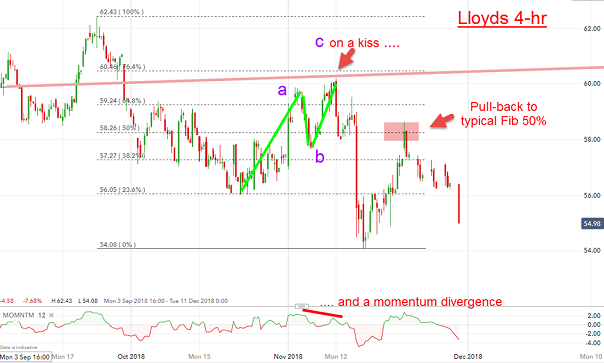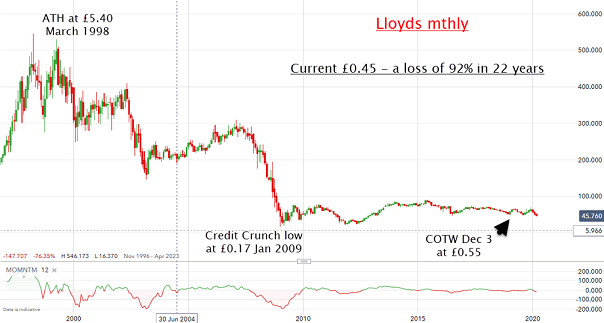Chart of the week: The outlook for Lloyds Banking Group shares
After calling the market crash correctly, analyst John Burford updates his view on Lloyds.
9th March 2020 09:45
by John Burford from interactive investor
After calling the market crash correctly, analyst John Burford updates his view on Lloyds.

There has been a sudden sea change in stock markets
Is there any share out there that is proving immune to the coronavirus? While a human vaccine may be months away, a financial vaccine is unlikely to be discovered for months, if not years. The Fed’s pop-gun of an historic 50 basis-point (bps) rate cut last week provoked waves of selling – continued with force Monday morning - and that contrary action set the seal on the new bear market being unleashed. That misfire was no accident.
There is little doubt that fears over a possible pandemic to sweep the Western world are growing fast, and that is having a direct and immediate effect on economic activity. But the underlying motivation for selling is the sudden reversal of mood. Before, complacency. Now, fear. And that transformation last month was in the blink of an eye. Most investors missed it.
We have had virus pandemics before – and markets mostly recovered quickly. But not this time.
And with corporate (and personal) debt levels at record highs, any fears that the servicing of these massive debt loads will be in jeopardy will/are sending shivers down the backs of money managers – and private investors alike. So even a small reduction in cash flows would bring into focus the spectre of bond defaults and then bankruptcy for some firms with the inevitable domino effect on others. The Fed has shot its wad and is out of ammo.
But even with record low interest rates, under this scenario, many commercial firms may not be able to roll their debt into this low rate regime. Corporate debt yields are already rising (bonds falling) in an ominous foretaste of what is to come.
And in the firing line of the above scenario, the major banks are front and centre. They hold the mountains of loans as assets that are suddenly vulnerable to downgrades. The ratings agencies received massive criticism after the 2008 Credit Crunch for not moving earlier to downgrade many poorly performing CDOs (collateralized debt obligation). Dare they repeat that mistake this time?
The ‘bad’ loan book from the 2008 Credit Crunch bucket appears set to expand. To add to the banks’ woes, new loans are reaping miserly returns with margins are razor-thin.
Long-time readers will know I have been bearish on Lloyds Banking Group (LSE:LLOY) for a very long time. The last time I covered it was on 3 December 2018 and this was the short-range chart then:

Source: interactive investor Past performance is not a guide to future performance
This is what I wrote:
The bottom line: Lloyds remains in a bear trend with major US banks downgrading their European ‘colleagues’ with Deutsche Bank (XETRA:DBK) one of the hardest hit (it has problems of its own). Those bad loans they carry are set to get a whole lot worse.”
Note that I was mentioning the bad loans as a negative over a year ago. Of course, in the meantime, the final 2019 rally phase has taken all assets higher, but that was the opportunity to re-assess investment strategies and prepare for the Big Bear.
Here is the long-term Lloyds chart updated:

Source: interactive investor Past performance is not a guide to future performance
Recall my analysis of FTSE in my COTW of 23 December:
“I expect a bear market in 2020”.
Events since then has helped to solidify my view.
The 2009 Credit Crunch low for Lloyds was the 17p mark. It would not surprise me to see that record broken in the months ahead. The severity of the economic and financial crisis to come will be far greater than in 2008.
I believe investors should now be concerned with the return of their investments rather than a return on their investments. A great wave of asset price deflation is upon us with crude oil at new lows.
Monday Flash: The FTSE is off by over 6% overnight as I write. Lloyds is trading at 40p – a low not seen since 2012.
For more information about Tramline Traders, or to take a three-week free trial, go to www.tramlinetraders.com.
John Burford is the author of the definitive text on his trading method, Tramline Trading. He is also a freelance contributor and not a direct employee of interactive investor.
These articles are provided for information purposes only. Occasionally, an opinion about whether to buy or sell a specific investment may be provided by third parties. The content is not intended to be a personal recommendation to buy or sell any financial instrument or product, or to adopt any investment strategy as it is not provided based on an assessment of your investing knowledge and experience, your financial situation or your investment objectives. The value of your investments, and the income derived from them, may go down as well as up. You may not get back all the money that you invest. The investments referred to in this article may not be suitable for all investors, and if in doubt, an investor should seek advice from a qualified investment adviser.
Full performance can be found on the company or index summary page on the interactive investor website. Simply click on the company's or index name highlighted in the article.
Disclosure
We use a combination of fundamental and technical analysis in forming our view as to the valuation and prospects of an investment. Where relevant we have set out those particular matters we think are important in the above article, but further detail can be found here.
Please note that our article on this investment should not be considered to be a regular publication.
Details of all recommendations issued by ii during the previous 12-month period can be found here.
ii adheres to a strict code of conduct. Contributors may hold shares or have other interests in companies included in these portfolios, which could create a conflict of interests. Contributors intending to write about any financial instruments in which they have an interest are required to disclose such interest to ii and in the article itself. ii will at all times consider whether such interest impairs the objectivity of the recommendation.
In addition, individuals involved in the production of investment articles are subject to a personal account dealing restriction, which prevents them from placing a transaction in the specified instrument(s) for a period before and for five working days after such publication. This is to avoid personal interests conflicting with the interests of the recipients of those investment articles.